The European Textile Labelling Regulation No. 1007/2011 of the European Parliament and Council of 27 September 2011 on textile fibre names and related labelling and marking of fibre composition of textiles will replace the German Textile Labelling Act on 8 May 2012.
The new European Textile Labelling Regulation replaces and amends numerous labelling obligations of the German Textile Labelling Act that was valid until that time.
Although the basic labelling obligations do not change and some obligatory labels are omitted, it should be noted that some obligatory labels have also been added.
The purpose of the European Textile Labelling Regulation is to enable the consumer to form a sufficient picture of the quality, usability and, in particular, the textile composition of the respective textiles offered. For this reason, the European Union saw itself compelled to issue a new European Textile Labelling Regulation that is valid and uniform throughout Europe. According to the European Textile Labelling Regulation, all textile products that are to be placed on the EU market must be properly labelled in accordance with the new regulation.
A textile product within the meaning of the European Regulation is a product which in its raw, semi-processed, processed, semi-processed, processed, semi-manufactured or made-up state contains exclusively textile fibres, irrespective of the process used for blending or combining (cf. Art. 3 para. 1 a of the Regulation).
Furthermore, it must be taken into account that according to the European Textile Labelling Regulation, numerous products are treated in the same way as textile products and must therefore be labelled in the same way as textile products. These include products that have a textile fibre content of at least 80% by weight.
In summary, it can be stated that online traders in particular must adapt to the changed obligations regarding the labelling of textiles. Since the basic obligations of the traders are still identical to the obligations that already existed under the German legal regulations, each trader must check whether and to what extent they must amend and/or supplement their existing labelling.
It should also be taken into account that the European Textile Labelling Regulation provides for a transitional period in Art. 26 of the Regulation. Textile products that were placed on the market before the deadline may still be sold with the old textile labelling according to the old German Textile Labelling Act until 09.11.2014. As of 10.11.2012, only textiles that are labelled in compliance with the new regulation from the European Textile Labelling Regulation may then be placed on the market.
However, it is not explicitly stated whether the transitional period only applies to manufacturers or whether traders can also invoke this transitional period for labelling. The wording actually speaks in favour of this assumption. However, since a violation of the European regulation can result in a warning under competition law, we advise all traders, especially online traders, to label their goods in accordance with the new European regulation as of 8 May 2012.
Please do not hesitate to contact us if you have any questions on this topic.
Goldberg Attorneys at Law
through
Michael Ullrich, LL.M. (Information Law)
Attorney at Law and
specialist attorney for information technology law
E-mail: info@goldberg.de


